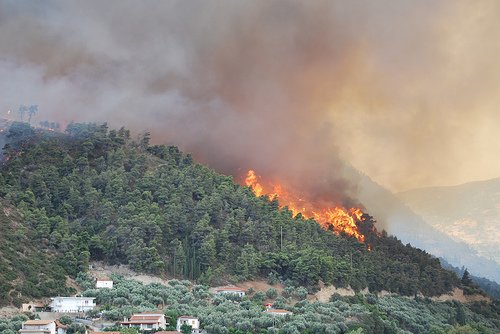
Fire regimes are commonly characterized by burn frequency and severity within a given area. Severity is often estimated as the proportion of overstory trees killed by fire. In general, as frequency increases, fuels have less time to accumulate, reducing intensity and subsequent tree mortality. Increased frequency and size of large, severe forest fires are expected in Australia, the Mediterranean Basin, Canada, Russia, and the United States.
The critical issue is whether tree mortality patch sizes (and their temporal and spatial frequency) allow recovery of the same or similar vegetation types. If high-severity patch sizes are too large, microclimates and regeneration mechanisms (e.g., seed abundance and dispersal) can limit tree reestablishment This may result in undesirable ecosystem changes. Rising temperatures, related drought stresses, and increased fuel loads are driving high-severity patches to extraordinary sizes in some areas.
Fire policy that focuses on suppression only delays the inevitable, promising more dangerous and destructive future forest fires. In contrast, land management agencies could identify large firesheds (20,000 to 50,000 ha) where, under specified weather conditions, managed wildfire and large prescribed fire are allowed to burn, sometimes after strategic mechanical fuel treatments. Acknowledging diversity in fire ecology among forest types and preparing forests and people for larger and more frequent fires could help reduce detrimental consequences. New strategies to mitigate and adapt to increased fire are needed to sustain forest landscapes. The following strategies have been suggested:
- Landowners should follow “Firewise” guidelines (www.firewise.org/) for houses and other infrastructure. Increased development in fire-prone landscapes has increased suppression costs, exacerbated risk to human safety and infrastructure, and reduced management options. People living in these forests must be prepared rather than relying solely on fire departments. Some places may be so hazardous that building should be prevented, discouraged, or removed (e.g., by regulation or insurance and/or tax incentives).
- Fire managers should avoid trying to uniformly blacken wildfire landscapes through burnout and mop-up operations, especially in burn interiors. As wildfire sizes have grown in recent decades, direct attack has been replaced with indirect attack, where fire lines are placed some distance from the active fire front, and then the area between is intentionally burned, often with high-severity fire, to reduce fuel and create a wider fire barrier. Unburned or partially burned patches are critical refugia that aid postfire recovery in forests of all fire regimes and should be conserved whenever possible.
- Land managers could anticipate changes using models of species distribution and ecological processes and should consider using assisted migration.
- Strategies should be based on a forest’s historical fire regime; in forests with historically high-frequency, low- to moderate-severity fire regimes the resilient forest structure should be restored similar to historical patterns that survived during past high-fire periods (and those anticipated in the future).
- Forest restoration should be funded.
Source: Stephens et al., 2013. Science 342, 4 October 2013: 41-42.
Photo: Lotus R. (www.flickr.com)








